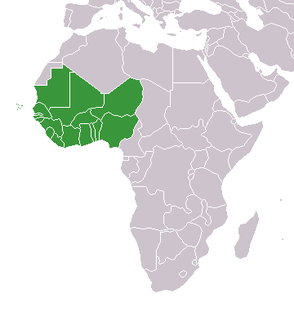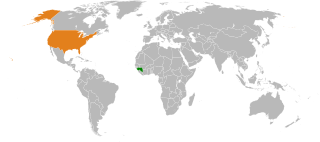
Equatorial Guinea, officially the Republic of Equatorial Guinea, is a country on the west coast of Central Africa, with an area of 28,000 square kilometres (11,000 sq mi). Formerly the colony of Spanish Guinea, its post-independence name evokes its location near both the Equator and the Gulf of Guinea. As of 2021, the country had a population of 1,468,777.

Guinea, officially the Republic of Guinea, is a coastal country in West Africa. It borders the Atlantic Ocean to the west, Guinea-Bissau to the northwest, Senegal to the north, Mali to the northeast, Cote d'Ivoire to the southeast, and Sierra Leone and Liberia to the south. It is sometimes referred to as Guinea-Conakry after its capital Conakry, to distinguish it from other territories in the eponymous region such as Guinea-Bissau and Equatorial Guinea. It has a population of 13.5 million and an area of 245,857 square kilometres (94,926 sq mi).

Guinea-Bissau, officially the Republic of Guinea-Bissau, is a country in West Africa that covers 36,125 square kilometres (13,948 sq mi) with an estimated population of 1,726,000. It borders Senegal to the north and Guinea to the south-east.

Liberia, officially the Republic of Liberia, is a country on the West African coast. It is bordered by Sierra Leone to its northwest, Guinea to its north, Ivory Coast to its east, and the Atlantic Ocean to its south and southwest. It has a population of around 5 million and covers an area of 111,369 square kilometers (43,000 sq mi). English is the official language, but over 20 indigenous languages are spoken, reflecting the country's ethnic and cultural diversity. The country's capital and largest city is Monrovia.

The Economic Community of West African States is a regional political and economic union of fifteen countries located in West Africa. Collectively, these countries comprise an area of 5,114,162 km2 (1,974,589 sq mi), and in 2015 had an estimated population of over 349 million.

The Gulf of Guinea is the northeasternmost part of the tropical Atlantic Ocean from Cape Lopez in Gabon, north and west to Cape Palmas in Liberia. The intersection of the Equator and Prime Meridian is in the gulf.

West Africa is the westernmost region of Africa. The United Nations defines Western Africa as the 16 countries of Benin, Burkina Faso, Cape Verde, The Gambia, Ghana, Guinea, Guinea-Bissau, Ivory Coast, Liberia, Mali, Mauritania, Niger, Nigeria, Senegal, Sierra Leone, and Togo, as well as Saint Helena, Ascension and Tristan da Cunha. The population of West Africa is estimated at about 419 million people as of 2021, and at 381,981,000 as of 2017, of which 189,672,000 are female and 192,309,000 male. The region is demographically and economically one of the fastest growing on the African continent.

The Mandinka, are a West African ethnolinguistic people present mainly in Mali, Guinea, Senegal, Gambia, Ivory coast, Ghana and Guinea-Bissau. The Mandinka are also present to a lesser extent in Sierra Leone and far north of Liberia, where they are very much in the minority. In terms of population, the Mandinka are estimated to number over 11 million. Etymologically speaking the term “Mandinka” or “Manding” is a deformation of the word mandenka, that is to say "inhabitant of Manden”, the historic centre of the Mali Empire. The term Malinké of Fulani origin is synonymous with Manding. The Mandinka or Manding are in several sub-groups as to which the Malinke gave birth to the Bambara, Dioula, Diakhanke and the Malinke themselves who constitute towards the Mandinka people. The Mandinka who speak Manding Languages are the largest subgroup of the Mande speaking peoples, which is one of the largest language groups in Africa. Over 99% of the Mandinka adhere to Islam. Their largest urban centre is Bamako, the capital of Mali.

A subregion is a part of a larger region or continent and is usually based on location. Cardinal directions, such as south are commonly used to define a subregion.

Asia-Pacific (APAC) is the part of the world near the western Pacific Ocean. The Asia-Pacific region varies in area depending on context, but it generally includes East Asia, Russian Far East, South Asia, Southeast Asia, Australasia and Pacific Islands.

Islam is the main religion in Guinea, followed by an estimated 90% of the population as of 2022. "Most are Sunnis who follow the Maliki legal tradition and Qadiri and Tijani Sufi orders."
The World Geographical Scheme for Recording Plant Distributions (WGSRPD) is a biogeographical system developed by the international Biodiversity Information Standards (TDWG) organization, formerly the International Working Group on Taxonomic Databases. The WGSRPD standards, like other standards for data fields in botanical databases, were developed to promote "the wider and more effective dissemination of information about the world's heritage of biological organisms for the benefit of the world at large". The system provides clear definitions and codes for recording plant distributions at four scales or levels, from "botanical continents" down to parts of large countries. Current users of the system include the International Union for Conservation of Nature (IUCN), the Germplasm Resources Information Network (GRIN), and the World Checklist of Selected Plant Families (WCSP).

Guinea – United States relations are bilateral relations between Guinea and the United States.

The cuisine of Equatorial Guinea is a blend of the cuisines of the native tribes, as well as that of Spain and Islamic states such as Morocco. Its cuisine incorporates various meats, including game and bushmeat as well as imports. Fish and chicken are common dishes.
Bissau-Guinean Americans are Americans of Bissau-Guinean descent. As was the case with almost all current West African coastal countries, the first people in the United States from present-day Guinea-Bissau were imported as slaves. Thus, in the 21st century, there are many African Americans who have discovered, through DNA analysis, they descend mainly or at least partly, from Bissau-Guinean enslaved people.

Guinean cuisine includes the traditional dishes of fou fou, boiled mango, fried plantains, patates and pumpkin pie.

Guinea–Turkey relations are the foreign relations between Guinea and Turkey. Guinea opened its embassy in Ankara and Turkey opened its embassy in Conakry in 2013.